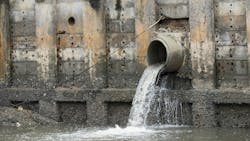From Runoff to Resource: Reimagining Stormwater Management
Key Takeaways
- Move from reactive to proactive monitoring: The industry should embrace real-time monitoring tools like Total Organic Carbon (TOC) analysis and rapid microbial methods rather than relying on traditional tools that take days to provide results.
- Invest in storage and treatment optimization: Given space limitations, facilities should focus on treatment intensification and optimize their performance through equalization tanks and diversion systems.
- Consider water reclamation opportunities: Rather than viewing stormwater purely as a problem, companies can integrate it into their water management strategy through reclamation.
As we move through the seasons, many of us reflect on the state of our environment, particularly our water resources. The quality of our rivers, lakes and streams plays a crucial role in our daily lives, from recreation to public health. One of the most significant challenges facing our waterways is pollution, often exacerbated by stormwater runoff.
Polluted waterways have wide-ranging impacts on our communities. They affect recreational activities such as swimming, as well as commercial agriculture, ranching and fishing.
Farmers may have to avoid using river water for irrigation, fearing crop contamination, or conversely, farmers may contaminate the river through nutrient runoff. Perhaps most critically, millions of people who rely on rivers for drinking water may face increased treatment costs or limited access to safe water.
Efforts to address these issues are ongoing, with cities and regions investing millions in infrastructure improvements. These include stormwater retention basins, treatment plants and collector tunnels to manage combined sewer overflows and upgrades to existing wastewater treatment plants and sewage networks. However, the challenge remains significant, with water quality standards often difficult to meet consistently.
What Should the Chemical Industry Do About Stormwater?
Is it merely a nuisance to be managed, or can we view it as an opportunity for innovation and improvement? Should we always be reactive to water quality issues, or can we take a more proactive approach?
We may or may not be able to have a significant impact on storm events in the long term, but in the short term, we have to deal with what Mother Nature delivers. Climate factors like low water, heavy water, air temperature and water temperature all influence environmental pollution. Extreme weather events, such as hurricanes and flash flooding, are becoming more frequent. At the same time, stormwater regulations are growing stricter.
A major challenge is combined sewer overflows (CSOs), which transport rainwater and, yes, also sewage during heavy storms to open water bodies to prevent or mitigate flooding. Even newer systems that separate rainwater and sewage can be overwhelmed by severe weather. (1).
Water Regulations
Storm events bring multiple pollution sources, including the rainwater itself, sewage seepage potentially from overflow, and industrial contribution. Industrial runoff is a significant contributor to stormwater contamination and subsequent environmental degradation. Spills and contaminated runoff from industrial sites often make headlines, and new regulations are holding manufacturers more accountable for pollution.
In response, many industries are not only aiming to avoid penalties but also embracing sustainability. This shift isn't just about compliance—it's about being part of the solution to water pollution and contributing to healthier ecosystems. They're investing in improved treatment methods and better contamination detection, reflecting a growing commitment to environmental responsibility and sustainable business practices.
Water Monitoring Solutions
Water monitoring solutions serve several key purposes, including:
- Checking the status of environmental quality
- Providing upstream insights into water quality and quantity changes, enabling informed decisions about diversion, treatment, discharge, or reuse
Microbiological pollution can be a major challenge in waterways. Heavy nutrient discharge of carbon, nitrogen and phosphorus, which are food for biological growth, can lead to harmful bacterial growth. (2). Thus, removing these nutrients is crucial for meeting environmental quality targets.
Many industrial facilities face challenges with wastewater treatment capacity. Those planning storm or excursion events equip themselves with ample equalization, diversion or calamity tanks. Given space limitations, treatment intensification and storage optimization are valuable strategies.
Diverting heavy loads of contamination and metering it back in during low production periods can significantly reduce wastewater costs and avoid penalties. The same approach can be applied during storm events. Key factors in treatment performance must address:
- Water volume
- Contamination levels of nutrients like carbon, nitrogen and phosphorus
Nutrient balancing is critically important to effectively remove these nutrients and avoid eutrophication. Carbon makes up the majority of this ratio, so tracking carbon loading from production and any runoff helps meet discharge limits. Monitoring carbon in wastewater improves treatment efficiency and discharge compliance.
There are many new innovations in water quality monitoring that provide reliable data faster. Historic measurements for carbon (biochemical oxygen demand and chemical oxygen demand, or BOD and COD) take days or a week to provide results, and the results have wide precision ranges, which makes it difficult to drive treatment effectively. Historic measurements for microbiology are plate counts that also take days and have even worse repeatability. In contrast, modern plants now use real-time monitoring instruments. These new tools offer advanced data management and predictive diagnostics, providing faster and more reliable results.
New Tools Revolutionized Water Quality Monitoring
These innovative water monitoring tools can be used by industries and cities to be proactive in preventing pollution events.
- Total Organic Carbon (TOC) analysis effectively measures wastewater carbon loading, separation and removal across the treatment train(s)
• TOC is capable of handling complex wastewater influent
• TOC also provides the sensitivity needed to get accurate wastewater effluent data - Modern microbiological tools provide data on bacteria in less than an hour:
• ATP testing is useful for influent and in-process wastewater
• Flow cytometry provides impressive sensitivity for discharge, environmental, and drinking waters
Removing Contamination
Treatment systems exist to remove contamination from industrial production and stormwater. These treatments can be combined with wastewater treatment. The primary goal is to achieve regulatory compliance and preserve environmental health and biodiversity. However, when treatment is sufficiently effective and efficient, it can also produce water suitable for on-site reuse or reclamation. For instance, reclaimed water can be used for equipment rinsing or washing, which may not need to meet high purity requirements. Rinsing and washing with reclaimed water can also help minimize stormwater contamination from the next storm event.
The aim of wastewater treatment is to minimize waste, and removing the potential for stormwater pollution can be an important part of this effort. Regardless of the specific application, monitoring water quality during storm events, including indicators of microbial growth and contamination, is crucial. This monitoring helps industries, municipalities, and cities in their efforts to clean up waterways and maintain environmental health.
References:
- Rudgard, Olivia; Shankleman, Jess; and Barteczko, Agnieszka. “E. Coli, Diarrhea and Dead Fish: Europe’s Rivers Have a Sewage Problem.” 14 August 2024. Bloomberg News.
- “European bathing water quality in 2023.” 9 July 2024. European Environment Agency.
About the Author
Amanda Tyndall
Amanda Tyndall is the Vertical Market Manager Industrial & Environmental for Veolia Water Technologies & Solutions Analytical Instruments. With 10 years experience in the water industry, Amanda and her team partner with industries and municipalities to solve water quality challenges through instrumentation solutions from ultrapure water to wastewater. Her background is in chemical engineering with a Bachelor's Degree from Vanderbilt University and a Masters Degree from University of Cambridge.

